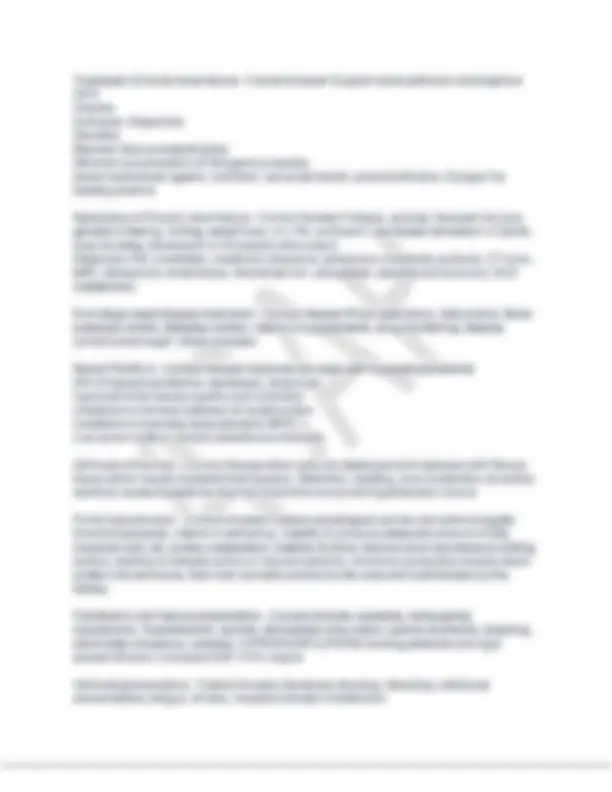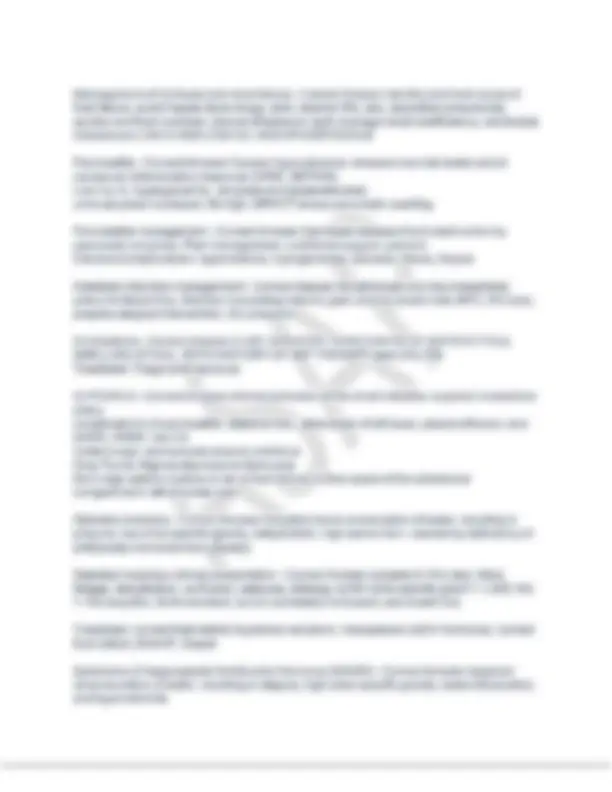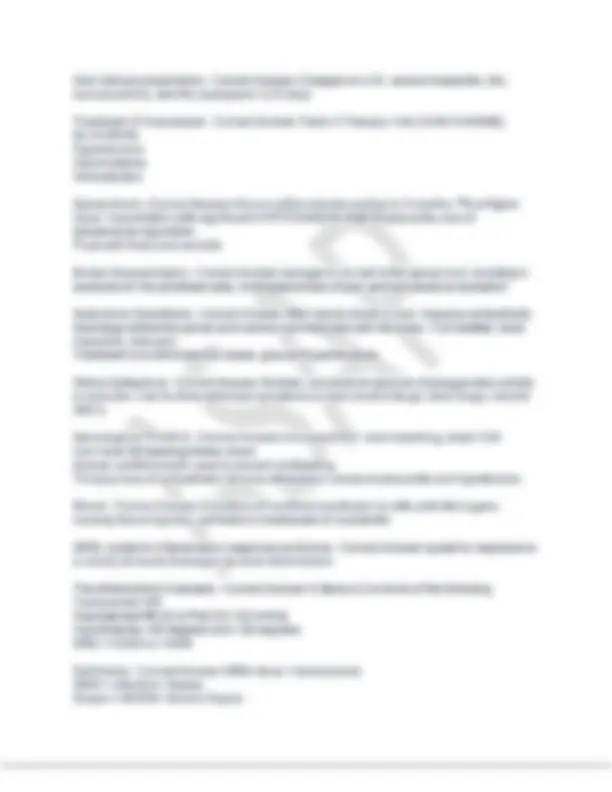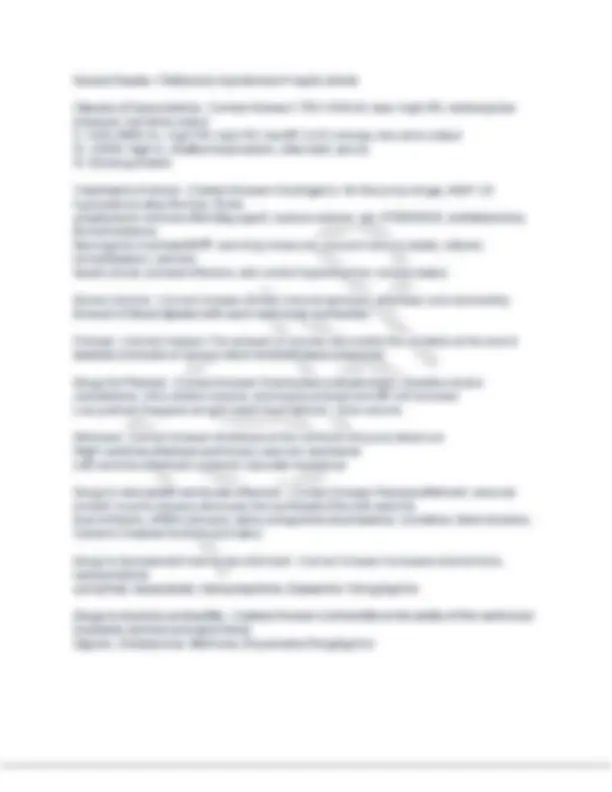Partial preview of the text
Download PCCN Exam Review with 100% Correct Answers. and more Exams Health sciences in PDF only on Docsity!
Thrombocytopenia - Correct Answer-Normal range 150,00-350,000, causes are heparin induced, DIC, Anti-platelet drugs DIC: Disseminated Intravascular Coagulopathy - Correct Answer-Syndrome characterized by thrombus formation and hemorrhage. Forms clots in small blood vessels in the body. Secondary to stimulation of normal coagulation process, with resultant decrease in clotting factors and platelets-platelet dysfunction. Factors triggering DIC - Correct Answer-Tissue factors: Tissue breakdown, Platelet aggregation: Sepsis, Injury to vascular endothelium and exposure to collagen... Etiology of DIC - Correct Answer-Vascular disorders, Infection and Sepsis, Hematological and immune disorders, Anaphylaxis- histamine release with fluid movement causing edema and vasodilation, blood transfusion reaction, massive blood transfusion, prolonged cardiopulmonary bypass, sickle cell crisis, transplant reaction, trauma, burns, acute anoxia, crush and head injury, cancer, OB complications Presentation of DIC - Correct Answer-Abnormal bleeding, signs of thrombosis, change in LOC, Chest pain, S-T & T wave changes, dyspnea, hypoxia, decreased urine output, protienuria, electrolyte imbalances, abdominal pain, diarrhea Clinical presentation of DIC - Correct Answer-1ST SIGN IS PETECHIAE, ecchymosis, purpura, and bleeding, Low platelets- <100,000, decreased fibrinogen <200 mg/100ml., decreased antithrombin III <70%, Increased PTT >60-90 seconds, Increased PT >15, Increased FDP/FSP >10g/mL, Increased D-Dimer >2mg/L (not clot specific, goes up in early sepsis) Treatment of DIC - Correct Answer-Treat underlying cause, medical management, stop bleeding, correct hypovolemia, hypotension, hypoxia, acidosis, stop microclotting to maintain perfusion, give blood products for bleeding Packed RBC's - Correct Answer-Action-Increase 02 capacity Indication- significantly decreased H&H, blood loss, active bleeding Administration-avoid fluid overload (CHF), blood filter, infuse 2-4 hours Complications- Transfusion reaction, infection, volume overload Platelet Products - Correct Answer-Action: Coagulation components Indications: Platelet count or decreased platelet function Administration: component filter, rapid infusion FFP (fresh frozen plasma) - Correct Answer-Action: increase clotting factors, water and electrolytes, has no platelets Indications: coagulation deficiencies Factor V and VIII - Correct Answer-Administration: filter, rapid infusion (can give over 2 hours) Complications: viral, fluid overload Cryoprecipitate - Correct Answer-Indications: Given for DIC, von Willebrands Actions: raises factors VIII + XIl, prevents and controls bleeding, contains fibrinogen and antithrombin III Administration- filter, give rapidly Adverse reactions of Blood transfusions - Correct Answer-Hyperkalemia, hypocalcemia, decreased 23dpg , ammonia intoxication, hypothermia, infection, fluid overload, Transfusion-related acute lung injury (TRALI) occurs within 6 hours of transfusion Renal Blood flow requirements - Correct Answer-MAP 80-180 mmHg Filtration ceases with MAP less than 40 mmHg Renal function assessment- creatinine, GFR, Urine output, weight changes/fluid changes Renal Labs - Correct Answer-Serum osmolality: 275-295 (increased osmolality=dry) BUN/Creatinine ratio 10:1 If disproportionate, Dehydration, Blood in gut, Catabolic states are causes Hypovolemia - Correct Answer-Tachycardia, NARROW pulse pressure, orthostatic hypotension, low filling pressures, high systemic vascular resistance, flat jugular veins, weakness, lethargy, anorexia, poor skin turgor, thirst, low-grade fever, syncope, oliguria, INCREASED BUN with NORMAL CREATININE, HIGH SERUM OSMOLALITY, INCREASED H&H (hemoconcentration). Management: Return Volume Hypervolemia Causes - Correct Answer-Excessive fluid intake, retention of NA and water. Caused by stress response, steroid therapy, heart failure, liver failure, nephrotic syndrome, acute or chronic renal failure Hypervolemia presentation and treatments - Correct Answer-Tachycardia, high blood pressure, high filling pressures, weight gain, JVD, tachypnea, dyspnea, lethargy, disorientation, indications of pulmonary or cerebral edema, LOW HGB, LOW SERUM OSMOLALITY, DECREASING BUN WITH NORMAL CREATININE Managmenet: Monitor 1&0, Decrease excess volume, Dialysis, fluid restriction, diuretics, prevent complications Acute renal failure - Correct Answer-Sudden severe impairment or cessation of kidney function: characterized by accumulation of nitrogenous wastes and fluid and electrolyte imbalances Pre-renal Failure - Correct Answer-Renal failure above the level of the kidney Treatment of Acute renal failure - Correct Answer-Support renal perfusion and improve GFR Volume Inotropes- Dopamine Diuretics Maintain fluid and electrolytes Diminish accumulation of nitrogenous wastes Avoid nephrotoxic agents, nurtrition, vanco/abt levels, prevent infection, Epogen for treating anemia Symptoms of Chronic renal failure - Correct Answer-Fatigue, anemia, frequent hiccups, general ill feeling, itching, weight loss, n/v, HA, confusion, decreased sensation in hands, easy bruising, decreased or increased urine output. Diagnosis: UA, creatinine, creatinine clearance, potassium, metabolic acidosis, CT scan, MRI, Ultrasound, renal biopsy. Abnormal Ca+, phosphate, parathyroid hormone, Vit D metabolism, End-stage renal disease treatment - Correct Answer-Fluid restrictions, diet control, blood pressure control, diabetes control, vitamin d supplements, drug monitoring, dialysis, control blood sugar, blood pressure Renal PEARLS - Correct Answer-Seizures are seen with hyperphosphatemia S/S of hypophophatemia: weakness, reciprocal hypercalcemia causes apathy and confusion creatinine is the best indicator of renal function creatinine is inversely proportional to GFR Low serum sodium causes aldosterone releases Cirrhosis of the liver - Correct Answer-liver cells are destroyed and replaced with fibrous tissue which results impaired liver function. Distortion, twisting, and constriction of central sections cause impedence of portal blood flow and portal hypertension occurs Portal hypertension - Correct Answer-Causes esophageal varices and splenomegaly- thrombocytopenia, vitamin k deficiency, inability to produce adequate amount of bile, impaired carb, fat, protein metabolism, inability to store vitamins and manufacture clotting factors, inability to detoxify toxins or remove bacteria. Ammonia production-breaks down protein into ammonia, then liver converts ammonia into urea and is eliminated by the kidney Fulminant Liver Failure presentation - Correct Answer-Jaundice, tachycardia, hypotension, fluid retention, ascites, decreased urine output, palmar erythema, bleeding, electrolyte imbalance, asterixis, HYPERVENTILATION-causing alkalosis and right pleural effusion, increased ICP, PVH, sepsis Cirrhosis presentation - Correct Answer-Azotemia, bruising, bleeding, nutritional abnormalities, fatigue, wt loss, impaired bilirubin metabolism Management of Cirrhosis and renal failure - Correct Answer-Identify and treat cause of liver failure, avoid hepato-toxic drugs, etoh, monitor Ift's, abc, aspiration pneumonia, ascites and fluid overload, pleural effusion on right, manage renal insufficiency, electrolyte imbalances LOW K AND LOW CA, HIGH PHOSPHORUS Pancreatitis - Correct Answer-Causes hypocalcemia, releases necrotic toxins which causes an inflammatory response (SIRS, SEPSIS). Low Ca, K, hyperglycemia , amylase and lipase elevated, urine amylase increased, Ifts high, MRI/CT shows pancreatic swelling Pancreatitis management - Correct Answer-Decrease release of and destruction by pancreatic enzymes. Pain management, nutritional support, prevent infection/complications- hypovolemia, hypoglycemia, abscess, fistula, Sepsis Intestinal infarction management - Correct Answer-Small bowel only has mesenteric artery for blood flow. Maintain circulating volume, pain control, bowel rest, NPO, NG tube, prepare surgical intervention, DC pressors Gl infections - Correct Answer-C-diff- GREATER THAN 3 DAYS OF WATERY FOUL SMELLING STOOL, WITH HISTORY OF ABT THERAPY and COLITIS Treatment- Flagyl and Vanco po GI PEARLS - Correct Answer-arterial perfusion of the small intestine: superior mesenteric artery complications of pancreatitis- bilateral riles, atelectasis of left base, pleural effusion, and ARDS, HHNK, low CA Cullen's sign- ecchymosis around umbilicus Grey Turner Sign-ecchymosis in flank area Ker's sign-splenic rupture or air or fluid (blood) in free space of the abdominal compartment- left shoulder pain Diabetes Insipidus - Correct Answer-Impaired renal conservation of water, resulting in polyuria, low urine specific gravity, dehydration, high serum Na+- caused by deficiency of antidiuretic hormone from pituitary Diabetes Insipidus clinical presentation - Correct Answer-polyuria 5-15 L/day, thirst, fatigue, dehydration, confusion, seizures, lethargy, LOW urine specific gravit < 1.005, NA > 145 meq/liter, BUN elevated, serum osmolality increased, serum adh low Treatment- correct fluid deficit, hypotonic solutions, Vasopressin (ADH hormone), correct fluid deficit, DDAVP, Diapid Syndrome of Inappropriate Antidiuretic Hormone (SIADH) - Correct Answer-impaired renal excretion of water, resulting in oliguria, high urine specific gravity, water intoxication, and hyponatremia acidosis causes shit of cellular K to serum SIADH- low Na, restrict fluid, 3% saline DI- hi Na; dehydration-give vasopressin (antidiuretic hormone) Cerebral perfusion pressure - Correct Answer-CPP= MAP- intracranial pressure (ICP) Normal CPP range - Correct Answer-60-100 mmhg (Remember 70) Normal ICP - Correct Answer-5-15 Normal MAP - Correct Answer-70-105- (Must be atleast 85 to make a CPP of 70, if ICP is 15 Nursing care of brain-inured patient - Correct Answer-ABC's, airway/ventilation, aspiration, ICP, CPP, MAP, DVT/PE, infections, volume status, rehab potential, B&B function Clinical picture of increasing ICP - Correct Answer-FIRST ALWAYS: Change in mental status VS changes- pule pressure widens, bradycardia Cranial nerve changes: change in pupil size- small and less reactive at first, vision, corneal reflex, swallow, contralateral motor changes, vomiting, HA, seizures Early signs of ICP - Correct Answer-Cushing's Triad Change in behavior- irritable Change in VS pupils restrict and become sluggishly reactive Complications of increased ICP - Correct Answer-Further ischemia, seizures, DI or SIADH, hydrocephalus, DVT, stress ulcers, Respiratory insufficiency, Increased c02, decreased respirations-slow and shallow Hydrocephalus - Correct Answer-accumulation of CSF causing increased ICP Treatment is shunt placement Subdural Hematoma - Correct Answer-venous bleed spnontaneously, older, ETOH Treatment Burr hole evacuation Epidural hematoma - Correct Answer-linear skull fracture, usually arterial bleeding. event causing unconsciousness, awake and normal, rapid decline and unconsciousness again Subarachnoid hemorrhage - Correct Answer-Intracranial bleed into the CSF filled space between the arachnoid and pia meter membranes on the surface of the brain, bleeding into the ventricular system. Frequently caused by hypertension and leaking aneurysm SAH clinical presentation - Correct Answer-Changes in LOC, severe headache, htn, seizure activity, identify vasospasm 3-21 days Treatment of Vasospasm - Correct Answer-Triple H Therapy- CALCIUM CHANNEL BLOCKERS Hypertension Hypervolemia Hemodilution Spinal shock - Correct Answer-Occurs within minutes and up to 3 months. T6 or higher injury. Vasodilation with significant HYPOTENSION AND Bradycardia, loss of temperature regulation- Treat with fluids and steroids Brown-Sequard injury - Correct Answer-damage to on half of the spinal cord, resulting in paralysis on the ipsilateral side, contralateral loss of pain and temperature sensation Autonomic Dysreflexia - Correct Answer-After spinal shock is over- massive sympathetic discharge where the spinal cord cannot communicate with the brain.- Full bladder, stool impaction, skin pain. Treatment is to eliminate the cause, give antihypertensives Status Epilepticus - Correct Answer-Sudden, paroxysmal episode of exaggerated activity or seizures- Can be from withdrawl symptoms or toxic level of drugs. Give drugs, monitor ABC's Neurological PEARLS - Correct Answer-Increased ICP- slow breathing, retain CO2 Can have Gl bleeding/stress ulcers Amicar- antifibrinolytic used to prevent re-bleeding T5 injury-loss of sympathetic nervous stimulation causes bradycardia and hypotension Shock - Correct Answer-Condition of insufficient perfusion to cells and vital organs causing tissue hypoxia, perfusion is inadequate to sustain life SIRS- systemic inflammatory response syndrome - Correct Answer-systemic response to a variety of insults that begin as local inflammation The Inflammatory Cascade - Correct Answer-Criteria is 2 or more of the following Tachycardia >90 Hyperapnea RR 20 or PaCO2 <32 mmhg Hypothermia <36 degrees and >38 degrees WBC >12000 or <4000 Definitions - Correct Answer-SIRS- fever + leukocytosis SIRS + infection= Sepsis Sespis + MODS= Severe Sepsis 

















